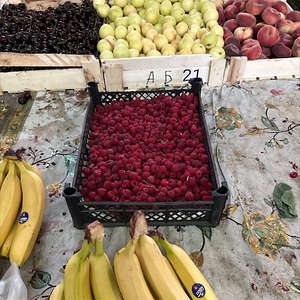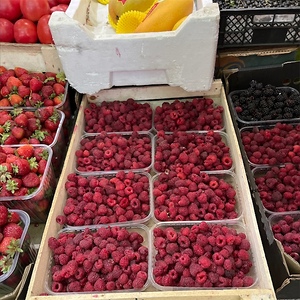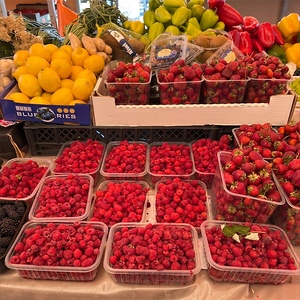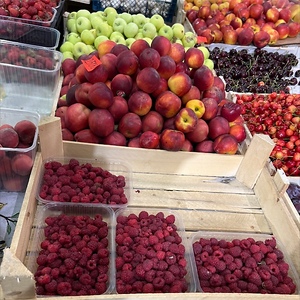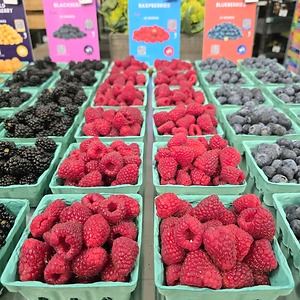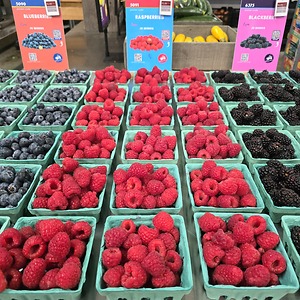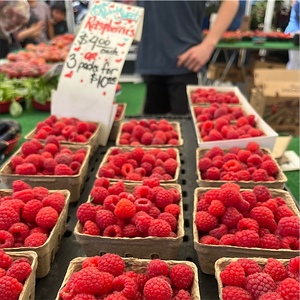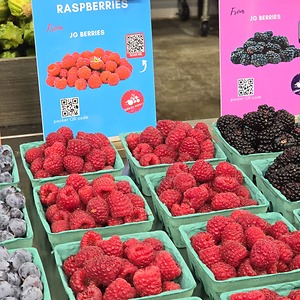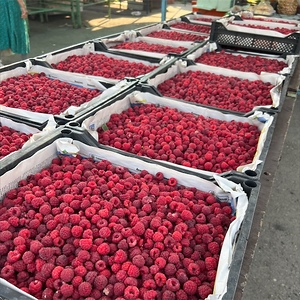


Raspberries
Estimated Inventory, 12 ct : 64.25
This item was last sold on : 07/24/25
Description/Taste
Raspberries are small, aggregate fruits that generally average 1 to 3 centimeters in diameter and have a round, oval, to oblong shape. Despite the fruits resembling berries, Raspberries are developed from tiny round drupelets that fuse together to create a solid but bumpy, textured, and bubbled appearance. Each clustered section, or drupelet, contains fine hairs, seeds, and juice, growing over a spongy core that remains with the plant once the fruit is picked. The fruit’s flesh is also typically soft, tender, juicy, and mildly crunchy as the drupelets encase 100 to 120 seeds in totality. There are many types of Raspberries appearing in hues of red, black, gold, and purple. When harvested, the fruits detach from the central core creating the signature hollow cavity. Raspberries have a bright and tangy, sweet-tart flavor, with earthy, jammy, and mouth-puckering nuances.
Seasons/Availability
Raspberries are available year-round, with peak season in the summer.
Current Facts
Raspberries, botanically classified as Rubus idaeus, are bramble fruits that grow on a perennial shrub belonging to the Rosaceae family. There are over 200 species of Raspberries found worldwide, varying in flavor, color, and texture, with the most popular commercial cultivars primarily being red. Raspberries have been cultivated since ancient times, and many of the Raspberries found in consumer markets in the modern-day are the result of years of natural and intentional crossbreeding to produce varieties with improved characteristics. The name Raspberry is hypothesized by experts to have been derived from the 16th-century word “raspis,” stemming from “raspise,” meaning “a sweet, blush-colored wine.” Over time, “raspis” became the most commonly used name for the fruit and in the 17th century, “raspis” was eventually shortened and altered into Raspberry to match other new fruit names, including blackberry and strawberry. Raspberries are widely favored worldwide for their bright flavoring and are frequently grown in both commercial and home gardens for culinary and medicinal use.
Nutritional Value
Raspberries are an excellent source of vitamin C to strengthen the immune system, reduce inflammation, and protect the cells against free radical damage. The fruits are also a good source of fiber to regulate the digestive tract, folic acid to develop red blood cells, potassium to balance fluid levels within the body, and contain other amounts of magnesium, calcium, vitamins A and C, copper, iron, and manganese.
Applications
Raspberries have a sweet-tart, tangy flavor well suited for savory and sweet culinary preparations. The fruits can be consumed straight, out of hand, or tossed into salads, mixed into fruit bowls, or stirred into yogurt, cereal, and oatmeal. Fresh, whole Raspberries can also be used as an edible garnish over tarts, cakes, and pies. In savory preparations, Raspberries can be cooked into sauces, glazes, vinaigrettes, and other dressings. Barbecue sauces, marinades, and homemade ketchup all benefit from a touch of Raspberry. The fruit’s complex taste also complements sweet applications, including simmering into jams, jellies, syrups, and preserves or used as a flavoring for sorbet, ice cream, and fillings for baked goods. In addition to culinary preparations, Raspberries can be incorporated into sparkling beverages, muddled into cocktails, blended into smoothies, or dried and steeped into herbal teas. Raspberries pair well with cheeses such as blue, sharp cheddar, and goat, almonds, white chocolate, dark chocolate, fruits including coconut, peaches, and blueberries, ginger, sesame, cinnamon, and herbs such as lavender, basil, thyme, and oregano. Unwashed Raspberries will keep 1 to 3 days when stored in a clamshell with good air circulation in the refrigerator. It is important to note that Raspberries will not continue to ripen after harvest, and ripe berries must be picked for a pleasant flavor. The fruits can also be frozen whole, pureed, or dried for extended use.
Ethnic/Cultural Info
In Greek folklore, Raspberries obtained their signature red hue from the nymph, Ida. Legend states that Raspberries were initially white. Ida was one of the nymphs tasked with keeping Zeus hidden from his father, Kronos, to save his life. The nymph lived with Zeus in a cave and was essentially his caretaker and nurse, nurturing the growing infant. One day when Ida was picking Raspberries for Zeus, she accidentally caught her skin on a thorn, leading her blood to be dropped onto the Raspberry bush, turning it red. Many attribute the fruit’s botanical name Rubus idaeus to be loosely connected to this story. The word Rubus roughly translates to mean “red,” and idaeus translates to mean “belonging to Ida,” a reference to the nymph or Mount Ida on Crete.
Geography/History
Raspberries are native to several temperate regions worldwide and are an ancient crop, growing wild for thousands of years. Within the Rubus genus, there are Raspberries native to Europe and Asia, while another red subspecies is native to North America. Experts theorize that the Raspberries found in North America may have been carried across the Bering Strait in the Early Ages from Asia. Raspberries were cultivated by the Ancient Romans and Greeks, especially loved by the residents of Troy, and were mentioned in the writings of Palladius, a Roman agriculturist in the 4th century. During this time, the leaves of the plant were also used in natural medicines and teas. Raspberries were introduced to civilizations across Europe through the Romans. In the 14th century, King Edward I encouraged Raspberry cultivation in England, and in the 18th century, Raspberries were brought to the New World, where they were widely planted in home gardens. Many different Raspberry hybrids were created in the 19th century, and the majority of these cultivars are the varieties sold in commercial cultivation in the modern day. Today Raspberries are cultivated worldwide through farms and home gardens and are commonly grown in Europe, Asia, North America, Australia, and regions of South America. In the United States, the fruits are produced in California, Washington, and Oregon, sold through supermarkets, distributors, and farmer’s markets.
Featured Restaurants
Restaurants currently purchasing this product as an ingredient for their menu.
| Solare Ristorante Lounge | San Diego CA | 619-270-9670 |
| Puesto-Mission Valley | San Diego CA | 619-804-4217 |
| Sheraton Carlsbad (20/20) | Carlsbad CA | 760-827-2400 |
| Mille Fleurs | Rancho Santa Fe CA | 858-756-3085 |
| Toast Catering | San Diego CA | 619-795-9135 |
| San Diego Yacht Club | San Diego CA | 619-758-6334 |
| Tom Hams Light House | San Diego CA | 619-291-9110 |
| Stone Brewing World Bistro & Gardens | Escondido CA | 915-861-2297 |
| The Switchboard Restaurant 2024 | Oceanside CA | 760-279-6300 |
| Parisien Gourmandises | La Jolla CA | 858-352-6552 |
| Catamaran | San Diego CA | 858-488-1081 |
| Invigatorium | San Diego CA | 855-634-7664 |
| One Door North | San Diego CA | 858-232-4220 |
| Blue Whale | La Jolla CA | 808-868-8639 |
| RoVino Rotisserie + Wine | San Diego CA | 619-972-6286 |
| Gelato 101 (Solana) | Solana Beach CA | 858-404-0799 |
| Fifty Two Remedies | San Diego San Diego | 858-707-7016 |
| Tartine | Coronado CA | 619-435-4323 |
| Monarch School | San Diego CA | 619-804-1766 |
| Belching Beaver Brewery Tavern and Grill | Vista CA | 760-509-4424 |
| The Santaluz Club Inc - Banquet | San Diego CA | 858-759-3150 |
| Sheraton Carlsbad (Banquets) | Carlsbad CA | 760-827-2400 |
| Pacific Regent La Jolla | San Diego CA | 858-597-8008 |
| Nadolife Production | San Diego CA | 619-239-1224 |
| Great Maple Hillcrest | San Diego CA | 619-255-2282 |
| Fish Guts | San Diego CA | 619-888-0081 |
| Pendry SD (Provisional) | San Diego CA | 619-738-7000 |
| Food by Chef Ty | Vista CA | 424-278-8626 |
| Belmont Park Cannonball | San Diego CA | 858-228-9283 |
| Louisiana Purchase | San Diego CA | 619-255-8278 |
| Hotel Indigo | San Diego CA | 619-295-3172 |
| Little Frenchie (Bar) | Coronado CA | 619-522-6890 |
| Poseidon on the Beach | Del Mar CA | 858-755-9345 |
| Bleu Boheme | San Diego CA | 619-255-4167 |
| UCSD Food & Nutrition Department La Jolla | San Diego CA | 858-761-1269 |
| Two Ducks (Deliver Lion Share) | San Diego CA | 619-564-6924 |
| Bayhill Tavern | San Diego CA | 858-288-6923 |
| Nobu | San Diego CA | 619-814-4124 |
| Michele Coulon Dessertier | San Diego CA | 858-456-5098 |
| Chocolate Bar | Carlsbad CA | 442-500-2007 |
| Harney Sushi | San Diego CA | 619-295-3272 |
| Ranch Catering | San Diego CA | 858-491-9100 |
| Paradise Point Resort Tidal | San Diego CA | 858-490-6363 |
| Noble Experiment | San Diego CA | 619-446-0002 |
| The Granger Hotel | San Diego CA | 619-559-7287 |
| Fresco Cocina | Carlsbad CA | 760-720-3737 |
| La Jolla Beach & Tennis Club | San Diego CA | 619-816-8319 |
| Syrah Spirit & Wine Parlor | San Diego CA | 619-234-4166 |
| Lil Piggy's | Coronado CA | 619-522-6890 |
| Belmont Park Draft | San Diego CA | 858-228-9283 |
| Craft and Commerce Bar | San Diego CA | 619-269-0288 |
| Brigantine La Mesa | La Mesa CA | 619-465-1935 |
| Miguel's Old Town | San Diego CA | 619-298-9840 |
| Farmer and The Seahorse | San Diego CA | 619-302-3682 |
| Seven Seas Roasting Co. | San Diego CA | 619-261-7275 |
| La Valle Coastal Club | Rancho Santa Fe CA | 858-759-5473 |
| Hyatt Islandia | San Diego CA | 619-224-1234 |
| Cape Rey Carlsbad, a Hilton Resort | Carlsbad CA | 760-602-0800 |
| Coronado Yacht Club | Coronado CA | 619-435-1848 |
| Choi's | San Diego CA | 858-900-1224 |
| Lodge at Torrey Pines Main | San Diego CA | 858-453-4420 |
| LANA | Solana Beach CA | 602-758-2596 |
| Encontro North Park | San Diego CA | 310-955-6333 |
| Maderas Golf Club | Poway CA | 858-451-8100 |
| Jensens Finest Foods - Produce | San Diego CA | 619-550-2097 |
| Brigantine Pt Loma | San Diego CA | 619-224-2871 |
| Brockton Villa Restaurant | San Diego CA | 858-454-7393 |
| Marisi La Jolla | La Jolla CA | 951-852-6730 |
| Miguel's Cocina Carlsbad | Carlsbad CA | 760-759-1843 |
| Crown Point Catering | San Diego CA | 619-223-1211 |
| Little Lion | San Diego CA | 619-519-4079 |
| Villa Capri Poway | Poway CA | 858-391-9400 |
| Raised By Wolves | San Diego CA | 916-207-1076 |
| Gilly's House of Cocktails | San Diego CA | 415-707-9219 |
| Savory Moment (1) | Carlsbad CA | 619-633-8863 |
| Spill the Beans (Seaport) | San Diego CA | 619-276-6700 |
| Southwestern Yacht Club | San Diego CA | 619-222-0438 |
| Stake Chophouse & Bar | Coronado CA | 619-522-0077 |
| Cliffhanger Cafe Menu | San Diego CA | 858-452-9858 |
| Sbicca Del Mar | Del Mar CA | 619-417-2587 |
| La Jolla Country Club | San Diego CA | 858-454-9601 |
| Frankie's | Oceanside CA | 442-266-2270 |
| The Cottage La Jolla | La Jolla CA | 858-454-8408 |
| Marriott Gaslamp | San Diego CA | 619-696-0234 x6051 |
| El Sueno (Bar) | San Diego CA | 619-972-6286 |
| Born & Raised | San Diego CA | 619-944-1631 |
| UCSD Food & Nutrition Department Hillcrest | San Diego CA | 619-380-9840 |
| Top of the Market | San Diego CA | 619-234-4867 |
| Portside Pier (Ketch Tasting Deck) | San Diego CA | 858-268-1030 |
| Rustic Root | San Diego CA | 619-232-1747 |
| The Lion Share Bar | San Diego CA | 619-564-6924 |
| The Flavor Chef (Catering) | Vista CA | 619-295-3172 |
| Extraordinary Desserts Union St. | San Diego CA | 619-294-7001 |
| Sheraton La Jolla | San Diego CA | 858-453-5500 |
| Venissimo Cheese Hillcrest | San Diego CA | 619-491-0708 |
| Darshan Bakery (Del Mar) | Del Mar CA | 858-925-7223 |
| Black Radish | San Diego CA | 619-775-7412 |
| Coast Catering | Escondido CA | 619-295-3173 |
| Rancho Santa Fe Golf Club | Rancho Santa Fe CA | 858-756-1582 |
| Craft House Sky Deck | San Diego CA | 619-948-4458 |
| Living Coast Discovery Center | Chula Vista CA | 619-409-5900 |
| Craft House Fashion Valley | San Diego CA | 619-948-4458 |
| Azucar | San Diego CA | 619-523-2020 |
| Misadventure & Co. | Vista CA | 469-580-1146 |
| The Victorian at Hill Street | Oceanside CA | 442-266-8285 |
| Marriott Del Mar | San Diego CA | 858-369-6029 |
| Le Parfait Paris - Downtown | San Diego CA | 619-245-4457 |
| Cutwater Spirits | San Diego CA | 619-672-3848 |
| Fairmont Grand Del Mar | San Diego CA | 858-314-1975 |
| Nolita Hall | San Diego CA | 619-618-8820 |
| Pendry SD | San Diego CA | 619-738-7000 |
| Green Acres Campus | San Diego CA | 858-450-9907 |
| Shogun Sportfishing | San Diego CA | 619-226-8030 |
| The Santaluz Club Inc - Main Dining | San Diego CA | 858-759-3150 |
| Panama 66 | San Diego CA | 619-206-6352 |
| Giaola | Carlsbad CA | 858-266-9303 |
| Smoking Gun (Spill the Beans) | San Diego CA | 619-276-6700 |
| Botanica | San Diego CA | 619-310-6320 |
| Sugar and Scribe | La Jolla CA | 858-274-1733 |
| Ketch Grill and Taps | San Diego CA | 858-268-1030 |
| WaterBar | San Diego CA | 619-308-6500 |
| Brigantine Coronado | Coronado CA | 619-435-4166 |
| Wildflour | San Diego CA | 619-289-9240 |
| Vista Valley | Vista CA | 760-758-2800 |
| Kettner Exchange | San Diego CA | 909-915-9877 |
| Tap Room Beer Co. | San Diego CA | 619-539-7738 |
| Dot to Dot Academy | San Diego CA | 858-485-1978 |
| Kingfisher | San Diego CA | 619-861-8074 |
| Pacific Coast Grill | Solana Beach CA | 858-794-4632 |
| Venissimo Cheese North Park | San Diego CA | 619-376-1834 |
| A & M catering | San Diego CA | 206-802-8320 |
| Brigantine Del Mar | Del Mar CA | 858-481-1166 |
| Saiko Sushi-Coronado | Coronado CA | 619-435-0868 |
| Richard Walkers Pancake House (LJ) | La Jolla CA | 858-459-8800 |
| Hilton Garden Inn | San Diego CA | 858-720-9500 |
| Selva Coffee | San Diego CA | 619-585-1118 |
| Daffodil Cafe | San Diego CA | 858-461-7788 |
| Plant Based Meals | San Diego CA | 858-255-0590 |
| Cal A Vie | Vista CA | 760-945-2055 |
| The Barista Botanist | San Diego CA | 808-868-8639 |
| Solana Beach Kitchen | Solana Beach CA | 610-717-7217 |
| Pacific Terrace Hotel | San Diego CA | 858-581-3500 |
| Waverly (Bar) | Cardiff CA | 619-244-0416 |
| Ctzn | Solana Beach CA | 858-925-7141 |
| Monarch School (Nutrition Lab) | San Diego CA | 619-804-1766 |
| Barbarella La Jolla | La Jolla CA | 858-454-7373 |
| Slowly | San Diego CA | 858-352-6080 |
| Spill the Beans (Mission Valley) | San Diego CA | 619-276-6700 |
| Del Mar Country Club | Rancho Santa Fe CA | 858-759-5995 |
| Kairoa Brewing Company | San Diego CA | 858-735-0051 |
| Good News Bar | San Diego CA | 541-233-7604 |
| PFC Fitness Camp | Carlsbad CA | 888-488-8936 |
| Viejas Casino | Alpine CA | 619-659-1774 |
| Crust Pizzeria Solana Beach | Solana Beach CA | 858-212-8751 |
| Harney Sushi Oceanside | Oceanside CA | 760-967-1820 |
| Spill the Beans (Ocean Beach) | San Diego CA | 619-276-6700 |
| Crest Cafe | San Diego CA | 619-295-2510 |
| InterContinental San Diego | San Diego CA | 619-501-9400 |
| Manna | Encinitas CA | 510-366-3057 |
| Trattoria I Trulli | Encinitas CA | 760-277-9826 |
| Kinme Omakase | San Diego CA | 619-231-0700 |
| El Sueno (TAKO Bar) | San Diego CA | 619-972-6286 |
| Juniper & Ivy | San Diego CA | 858-481-3666 |
| Sonny's Pizza | San Diego CA | 619-432-1838 |
| Barleymash | San Diego CA | 619-255-7373 |
| Third Corner Encinitas | Encinitas CA | 760-942-2104 |
| InterContinental Vistal Kitchen | San Diego CA | 619-501-9400 |
| The Farm Golf Club | Rancho Santa Fe CA | 858-756-5585 |
| Saint Mark Golf and Resort, LLC (Bar) | San Marcos CA | 508-320-6644 |
| The Wild Thyme Company | San Diego CA | 858-527-0226 |
| Terra Restaurant | San Diego CA | 619-293-7088 |
| Palmys | San Diego CA | 858-886-7111 |
| The Santaluz Club Inc - Bistro Kitchen | San Diego CA | 858-759-3150 |
| Hilton La Jolla Torrey Pines | La Jolla CA | 858-450-4581 |
| La Dona | San Diego CA | 858-352-8134 |
| Birdseye Rooftop | San Diego CA | 619-206-7220 |
| Lumi | San Diego CA | 619-955-5750 |
| Mister A's Pastry | San Diego CA | 619-239-1377 |
| The Shores | La Jolla CA | 858-459-8271 |
| Richard Walkers Pancake House (DM) | Del Mar CA | 619-306-2999 |
| Shoreside Support Boat | San Diego CA | 704-277-7929 |
| The Glen at Scripps Ranch | San Diego CA | 858-444-8500 |
| Reata Glen | Ladera Ranch CA | 949-545-2250 |
| Junkyard Sports Bar and Grill | Oceanside CA | 760-407-8500 |
| Lafayette Hotel - Mississippi Kitchen | San Diego CA | 619-296-2101 |
| Rustic Root Solana (Bar) | Solana Beach CA | 619-955-5750 |
| Convention Center Shell | San Diego CA | 619-954-3063 |
| Continental Catering Inc | La Mesa CA | 907-738-9264 |
| Brigantine Imperial Beach Bar | Imperial Beach CA | 619-591-1350 |
| C 2 C | San Diego CA | 619-972-9345 |
| Spill the Beans (Pacific Beach) | San Diego CA | 619-276-6700 |
| Saint Mark Golf and Resort, LLC | San Marcos CA | 508-320-6644 |
| Glenbrook Health Center | Carlsbad CA | 760-704-1000 |
| InterContinental Banquet Kitchen | San Diego CA | 619-501-9400 |
| Giuseppe Restaurants & Fine Catering | San Diego CA | 619-436-7006 |
| Alila Marea Beach Resort | Encinitas CA | 805-539-9719 |
| Institutes of Health LLC | San Diego CA | 800-270-5016 |
| Red Tail Catering | San Marcos CA | 858-605-8219 |
| Prey Brewing Company | Vista CA | 760-822-4226 |
| Lauberge Del Mar | Del Mar CA | 858-259-1515 |
| Olive Tree Marketplace | San Diego CA | 619-224-0443 |
| Cove House | La Jolla CA | 858-999-0034 |
| LPM Master Tenant, LLC- Bottlecraft | San Diego CA | 619-522-6890 |
| Manhattan of La Jolla | La Jolla CA | 858-459-0700 |
| Piatti | San Diego CA | 858-454-1589 |
| Alejandra's Cocina | Carlsbad CA | 858-500-5075 |
| Extraordinary Desserts | San Diego CA | 619-294-2132 |
| Cloak and Petal Bar | San Diego CA | 619-501-5505 |
| South O Brewing Catering | Oceanside CA | 925-381-5392 |
| The Tavern Bar | Coronado CA | 602-628-5890 |
| The Beau Hotel | San Diego CA | 619-310-5160 |
| Firefly Beach | San Diego CA | 619-222-6440 |
| Eddie V's La Jolla - EV# 8511 | La Jolla CA | 858-459-5500 |
| Urban Kitchen Catering | San Diego CA | 619-276-8803 |
| Eddie V's Prime Seafood - EV# 8514 | San Diego CA | 619-615-0281 |
| Rustic Root Solana | Solana Beach CA | 619-955-5750 |
| Campfire Bar | Carlsbad CA | 858-231-0862 |
| Pendry SD (Pool House) | San Diego CA | 619-738-7000 |
| Bridges at Rancho Santa Fe | Rancho Santa Fe CA | 858-759-6063 |
| Spirit of Adventure Sportfishing | San Diego CA | 619-454-9711 |
| Lilo | Carlsbad CA | 619-385-0914 |
| Hilton Harbor Island | San Diego CA | 619-291-6700 |
| Humphrey's | San Diego CA | 619-224-3577 |
| Searcher Sportfishing | San Diego CA | 619-861-4640 |
| Four Seasons Residence Club | Carlsbad CA | 760-603-6360 |
| Culinary Kitchen Catering and Events | Coronado CA | 619-798-8477 |
| Born & Raised (Bar) | San Diego CA | 619-550-5412 |
| Black Raill Kitchen + Bar | Carlsbad CA | 619-454-9182 |
| UCSD La Jolla (Pritikin Intensive) | San Diego CA | 858-657-6473 |
| Brigantine Poway Bar | Poway CA | 858-486-3066 |
| Rancho Valencia | Del Mar CA | 858-756-1123 |
| Hazel & Jade Bakery | San Diego CA | 804-815-8052 |
| Madison | San Diego CA | 619-822-3465 |
| Royal Polaris Sportfishing | San Diego CA | 619-226-8030 |
| JRDN Restaurant | San Diego CA | 858-270-5736 |
| Lafayette Hotel - Beginners Diner | San Diego CA | 619-296-2101 |
| Burgo Direct | Chula Vista CA | 619-793-2325 |
| Coco Maya by Miss Bs | San Diego CA | 858-245-3780 |
| Hilton Garden Inn - Homewood Suites San Diego | San Diego CA | 619-696-6300 |
| Pamplemousse Grill | Solana Beach CA | 858-792-9090 |
| Sycuan Casino | El Cajon CA | 619-445-6002 |
| Small Barn | Temecula CA | 951-225-2822 |
| JRDN Bar | San Diego CA | 858-270-5736 |
| Huntress | San Diego CA | 619-955-5750 |
| Asti Ristorante | San Diego CA | 619-232-8844 |
| Culinary Concepts | San Diego CA | 619-865-1918 |
| University Club | San Diego CA | 619-234-5200 |
| The Flower Pot Cafe and Bakery | La Jolla CA | 858-454-5453 |
| The Seabird Resort | Oceanside CA | 442-222-9505 |
| Comedor Nishi | La Jolla CA | 619-549-9919 |
| Polaris Supreme | San Diego CA | 619-390-7890 |
| Fox Point Farms | Encinitas CA | 619-892-0553 |
| Bistro du Marche by Tapenade | La Jolla CA | 858-551-7500 |
| US Grant Hotel Main | San Diego CA | 619-232-3121 |
| Bali Hai Restaurant | San Diego CA | 619-222-1181 |
| Venissimo Cheese Del Mar | Del Mar CA | 858-847-9616 |
| All Aboard Charcuterie & Provisions | San Diego CA | 619-994-5267 |
| Ketch Grill and Taps (Bar) | San Diego CA | 858-268-1030 |
| The Handmade Chef Meal Prep Co. | San Diego CA | 619-368-3705 |
| US Grant Hotel Grill | San Diego CA | 619-232-3121 |
| Kona Kai Resort and Marina | San Diego CA | 619-221-8000 |
| Waverly | Cardiff CA | 619-244-0416 |
| Georges at the Cove | San Diego CA | 858-454-4244 |
| Bahia Resort Hotel | San Diego CA | 858-488-0551 |
| Cork & Stem LLC | San Diego CA | 619-354-0308 |
| Vertex - Merryfield Row | San Diego CA | 619-405-8950 |
| Toast Cafe | San Diego CA | 858-208-9422 |
| Richard Walkers Pancake House (Carls.) | Carlsbad CA | 619-306-2999 |
| Little Frenchie | Coronado CA | 619-522-6890 |
| Miguel's Cocina Pt Loma | San Diego CA | 619-224-2401 |
| insideOUT | San Diego CA | 619-888-8623 |
| Beach Terrance Inn | Carlsbad CA | 760-729-5951 |
| Il Giardino di Lilli | La Jolla CA | 619-467-9897 |
Recipe Ideas
Recipes that include Raspberries. One



